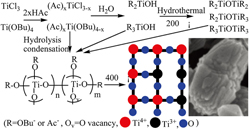Crossref Citations
This article has been cited by the following publications. This list is generated based on data provided by
Crossref.
Huang, Hongqin
Li, Fang
Wang, Huigang
and
Zheng, Xuming
2017.
The size controlled synthesis of Cu2S/P25 hetero junction solar-energy-materials and their applications in photocatalytic degradation of dyes.
RSC Adv.,
Vol. 7,
Issue. 79,
p.
50056.
Zhang, Hui
Sun, Runjun
Wu, Hailiang
and
Mao, Ningtao
2018.
Enhanced photocatalytic activity of wool fibers having titanium dioxide nanoparticles formed inside their cortex.
Nanotechnology,
Vol. 29,
Issue. 29,
p.
295606.
Li, Yuxin
Fu, Rong
Wang, Xiangdong
and
Guo, Xiaoling
2018.
Preparation of core–shell nanostructured black nano-TiO2 by sol–gel method combined with Mg reduction.
Journal of Materials Research,
Vol. 33,
Issue. 24,
p.
4173.
Zhang, Jianchao
Shi, Rongrong
Zhang, Chen
Li, Lingyun
Mei, Jiaming
and
Liu, Shengqing
2018.
Solvothermal synthesis of manganese sulfides and control of their phase and morphology.
Journal of Materials Research,
Vol. 33,
Issue. 24,
p.
4224.
Zhao, Zengying
Feng, Mingchao
Peng, Zhijian
Huang, Hongwei
Guo, Zhanhu
and
Li, Zhaohui
2018.
Molten-salt fabrication of (N,F)-codoped single-crystal-like titania with high exposure of (001) crystal facet for highly efficient degradation of methylene blue under visible light irradiation.
Journal of Materials Research,
Vol. 33,
Issue. 10,
p.
1411.
Mahto, Madhusudan Kr.
Samanta, Dipanjan
Konar, Suraj
Kalita, Himani
and
Pathak, Amita
2018.
N, S doped carbon dots—Plasmonic Au nanocomposites for visible-light photocatalytic reduction of nitroaromatics.
Journal of Materials Research,
Vol. 33,
Issue. 23,
p.
3906.
Li, Changxin
Liu, Yan
Zhang, Yanzong
Long, Lulu
Shen, Fei
Yang, Gang
Zhang, Xiaohong
He, Yan
Wang, Lilin
and
Deng, Shihuai
2019.
Electro-assisted ammonium persulfate activation to promote the introduction of N and S into TiO2 film: Enhancing its photoelectrocatalytic performance under solar.
Journal of Materials Research,
Vol. 34,
Issue. 20,
p.
3573.
Gonçalves, Bruno S.
Silva, Lucas M.C.
de Souza, Tarcizo C.C.
de Castro, Vinícius G.
Silva, Glaura G.
Silva, Bruno C.
Krambrock, Klaus
Soares, Renata B.
Lins, Vanessa F.C.
Houmard, Manuel
and
Nunes, Eduardo H.M.
2019.
Solvent effect on the structure and photocatalytic behavior of TiO2-RGO nanocomposites.
Journal of Materials Research,
Vol. 34,
Issue. 23,
p.
3918.
Zammouri, Lobna
Aboulaich, Abdelhay
Capoen, Bruno
Bouazaoui, Mohamed
Sarakha, Mohamed
Stitou, Mostafa
and
Mahiou, Rachid
2019.
Synthesis of YAG:Ce/ZnO core/shell nanoparticles with enhanced UV-visible and visible light photocatalytic activity and application for the antibiotic removal from aqueous media.
Journal of Materials Research,
Vol. 34,
Issue. 08,
p.
1318.
Tian, Mengkun
Liu, Chenze
Ge, Jingxuan
Geohegan, David
Duscher, Gerd
and
Eres, Gyula
2019.
Recent progress in characterization of the core–shell structure of black titania.
Journal of Materials Research,
Vol. 34,
Issue. 07,
p.
1138.
Xi, Junting
Zhang, Yiping
Chen, Xing
and
Hu, Ying
2020.
A simple sol–gel hydrothermal method for the synthesis of defective TiO2 nanocrystals with excellent visible-light photocatalytic activity.
Research on Chemical Intermediates,
Vol. 46,
Issue. 4,
p.
2205.
Qiu, Huan
Ma, Xujun
Sun, Chunyu
Zhao, Bin
and
Chen, Feng
2020.
Surface oxygen vacancies enriched Pt/TiO2 synthesized with a defect migration strategy for superior photocatalytic activity.
Applied Surface Science,
Vol. 506,
Issue. ,
p.
145021.
Chen, Yaqian
Li, Juan
Li, Xiangnan
Luo, Fengying
Wang, Zeyu
Wu, Liangpeng
and
Li, Xinjun
2021.
Copper oxide nanoparticles confined in TiO2 nanotubes for the water–gas shift reaction: promotional effect of potassium.
Journal of Materials Research,
Vol. 36,
Issue. 21,
p.
4475.
暴, 丽霞
2021.
Progress in Preparation and Characterization of Black TiO<sub>2</sub>.
Material Sciences,
Vol. 11,
Issue. 03,
p.
247.
Feng, Li-rong
Maimaiti, Halidan
Sun, Jin-yan
Bao, Jian-zhao
and
Zhao, Xu-wei
2022.
Preparation of Ti3+-TiO2 Supported Petroleum Pitch-Based Three-Dimensional Graphene Oxide Composite Photocatalysts for Photocatalysis of N2/H2O into Ammonia.
The Journal of Physical Chemistry C,
Vol. 126,
Issue. 10,
p.
4762.
Prekodravac, Jovana
Giannakoudakis, Dimitrios A.
Colmenares, Juan Carlos
Nair, Vaishakh
Vasiljević, Bojana
and
Kepić, Dejan
2023.
Novel Materials for Environmental Remediation Applications.
p.
361.
Sun, Peng
Han, Sumei
Liu, Jinhua
Zhang, Jingjing
Yang, Shuo
Wang, Faguo
Liu, Wenxiu
Yin, Shu
Ning, Zhanwu
and
Cao, Wenbin
2023.
Introducing oxygen vacancies in TiO2 lattice through trivalent iron to enhance the photocatalytic removal of indoor NO.
International Journal of Minerals, Metallurgy and Materials,
Vol. 30,
Issue. 10,
p.
2025.
Roy, Kunal
Rani M, Navya
Sardar, Tathagata
Joshi, Rita
P N, Manikanta
Sriramoju, Jagadeesh Babu
Yelamaggad, Channabasaveshwar V.
Gowda, Ashwin C.
and
Rangappa, Dinesh
2024.
Enhanced Electrochemical Energy Storing Performance of gC3N4@TiO2-x/MoS2 Ternary Nanocomposite.
ACS Applied Energy Materials,
Vol. 7,
Issue. 18,
p.
8110.
